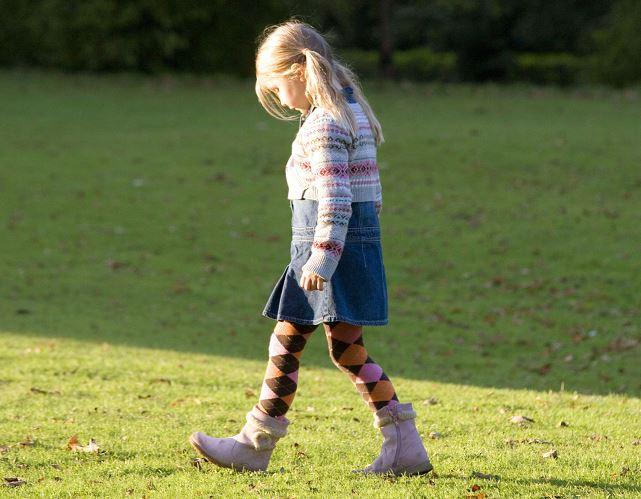
Credit: Thinkstock
In an article this month in Slate, Hanna Rosin wrote of the case of the Maryland couple currently under investigation by the state’s Child Protective Services agency for allowing their kids to walk home unescorted. As she reported, in late December 2014 Danielle and Alexander Meitiv allowed their 10-year-old son, and his six-year-old sister, to walk home from a playground located about a mile from their house. Someone called the police who, after stopping to question the kids, drove them home. The parents have not been charged, and The Washington Post reported that the family was set to meet at CPS offices in Rockville, Maryland.
|
Rosin is outraged at a society that doesn’t recognize the value of creating self-reliant children, and at a police state that dares to question parents about such innocuous behavior as walking home.
|
It is not clear from her article if Rosin interviewed the parents. I assume that she drew her information from the same newspaper sources I did, although The Washington Post doesn’t include a lot of information about the daily life of these kids in their reporting. What is clear, however, is Rosin’s stand on the matter: She’s outraged at a society that doesn’t recognize the value of creating self-reliant children, and at a police state that dares to question parents about such innocuous behavior as walking home. Furthermore, she wants us to share in her outrage.
But is her outrage, or ours, warranted here?
Perhaps we should save our anger for the story of Debra Harrell, the South Carolina mom who, in July of last year, made headlines when she was arrested for leaving her nine-year-old daughter alone in a park while she worked at a nearby McDonalds. Harrell was charged with “unlawful conduct towards a child” and is now in jail, and her daughter in the custody of social services. The Meitevs are Caucasian, Ms. Harrell is African-American. These two stories are troubling and noteworthy, not in the least because they appear to highlight a double standard on the part of the city and state authorities in assessing a parent’s competency based on race.
|
But these stories also highlight another double standard — or outright paradox — of contemporary culture; our simultaneous disdain for helicopter parenting and our headline-generating alarm over children left to play, walk, or take the subway home alone.
|
But these stories also highlight another double standard—or outright paradox—of contemporary culture: our simultaneous disdain for helicopter parenting and our headline-generating alarm over children left to play, walk, or take the subway home alone. Damned if we do and questioned or arrested if we don’t, modern parents are given wildly different messages about how and when children should act independently.
At the end of her article Rosin asserts that the solution is simple:
"'We are frightened and confused,’ [the Meitevs said]. So are lots of American parents, for different reasons. They are frightened of phantom dangers, confused about why their children are living childhoods that are so much more restricted than their own. The solution, however, is relatively simple: Parent more like the Meitevs, from a place of trust and not fear. Assess the risks in a reasonable way. Value independence alongside safety. For starters, teach your children to walk to the playground alone."
***
|
Rosin’s recommendations fail to acknowledge or consider the radical change in our communities and the way in which today’s families choose to live.
|
On the surface Rosin’s solutions do appear simple to install and reasonable to aspire to. A closer look, however, reveals that they are not simple, but simplistic. Here's why: Rosin’s recommendations fail to acknowledge or consider the radical change in our communities and the way in which today’s families choose to live.
I’m not suggesting that childhood is inherently more dangerous than thirty-something years ago when I roamed free, or that families have deviated so far from the deified nuclear model of the 1950s. Statistics prove otherwise. Families are still groups of people organized around and bound by the love and desire to raise children, no matter who is leading the household, and objectively there is a greater awareness overall as to how to keep kids alive by their teen years. This is evident in the multitude of safety devices and policies centered around kids, as well as our increased understanding of what constitutes emotionally healthy parenting.
|
Teaching my kid to walk home alone is not where I start fostering her independence; it is the end result of a conscientious, collaborative effort to create a safe space in which she can walk.
|
But there is no denying that our villages are decidedly different than my 1970s vintage model. Teaching my kid to walk home alone is not where I start fostering her independence; it is the end result of a conscientious, collaborative effort to create a safe space in which she can walk.
Rosin and the Post report that the Meitevs consciously subscribe to the “free-range” movement made popular by Lenore Skenazy; “Usually, their mother said, the children carry a laminated card with parent contact information that says: ‘I am not lost. I am a free-range kid.’” It’s reported that the children didn’t have the card with them on the day they were questioned by police.
In principle, I’m a fan of Skenazy, a journalist and author of the book and website Free Range Kids, and her research and reporting on the modern cocoons we’ve built for our children. Her work sheds light on what is lost when we eliminate opportunities for our children to learn about their strengths and weaknesses firsthand—when we severely reduce the number of situations and settings where they may discover their own abilities and test their own limits; situations where they may mediate relationships and interactions with other kids (and adults) on their own, outside of school, and settings where they may learn, through trial and error, the simple laws of cause and effect by, say, allowing their gloves to get soaking wet on a freezing cold day.
|
The truth is this: there was an entire village of moms, and dads, and neighbors, and extended family watching the kids when I was a child.
|
But Skenazy’s work also gives credence to the persistent myth of the “unwatched child” who roamed the urban and suburban landscapes of the '60s, '70s, and '80s. This original “free-range” child is often summoned forth by today’s parents with a nostalgia for their own childhood, or used by grandparents to point out what contemporary parents are doing wrong.
But that child is a myth! It’s an entirely false memory being used to indict today’s parents and promote sales of retro board games. The truth is this: There was an entire village of moms, and dads, and neighbors, and extended family watching the kids when I was a child.
***
|
Who remembers being busted by another parent for doing any number of unlawful or unsafe things several blocks from your own house?
|
In 1975 there were multiple pairs and of eyes and ears assisting “stay-at-home parents” in doing their job, which, back then, didn’t even warrant a special term—we just called them "moms." These perpetually occupied neighborhoods afforded us the chance to roam around seemingly free and unwatched. But we were watched, constantly.
Who remembers being busted by another parent for doing any number of unlawful or unsafe things several blocks from your own house? And knowing that a call to your mother—or worse, your father—was forthcoming, after the thorough tongue lashing of the neighbor who caught you in the first place. Who can remember some strange mom appearing out of nowhere like an angel, with a cold wash cloth and band aids, when you painfully wiped out on your bike on the gravel driveway?
Simply put, people were home back then.
This is in no way meant to indict working parents. My husband and I are working parents. There are many reasons for the change in the way we parent and the way our kids live, and many of them are good. They reflect our progress as a culture. But in creating new and better societies we lost some of the good parts of our old way of living. It used to be that your community came with the three-bedroom house you bought or the five-room apartment you rented. Your village came with your backyard, or front stoop, or alleyway, and that village often included grandparents, aunts, uncles, and cousins. And simply by virtue of location one could assume that you and your neighbors shared a certain set of values, block by socio-economic block.
|
Now, when mom and dad need a break there’s no relief in sight that doesn’t come with a fee. Today’s parents are required to build their villages from scratch and quite frankly, community building is hard work.
|
There was daily and weekly contact with your neighbors, too, and kids played together in the street without adult mediation. Now, it’s not unusual to live many miles away from where you were born and raised. Or for your siblings, parents, or extended family to have moved far away from you. Now, when mom and dad need a break, there’s no relief in sight that doesn’t come with a fee. Today’s parents are required to build their villages from scratch and quite frankly, community building is hard work.
Particularly when the previous, traditional points of community contact—the school yard, grocery store, church, or temple—won’t do anymore, because both mom and dad are working, or because five kids on any given block attend five different schools and a multitude of different after-school activities. It’s hard to feel connected when your next-door neighbors are having very different, daily experiences. Even getting your entire family together in the same place at the same time, more than one night a week, seems impossible.
These increased choices as to how and where we live, and to where our kids attend school, are changing the very nature of our villages. An increase of choices in how and where we work has changed our village, too. Many moms and dads now work from home, and it is their children that do the commuting. But even working from home is no guarantee that you’ll know your neighbors because it’s often a single, solitary affair punctuated by trips to Staples or the post office in your car.
|
The changes in the way we live have disconnected us from our communities. It has made us strangers living on the same block—and that strangeness creates fear.
|
The changes in the way we live have disconnected us from our communities. It has made us strangers living on the same block—and that strangeness creates fear. And that fear makes a person call the police, rather than stop to talk to two little kids walking home.
***
I applaud the Meitevs and other parents who want their children to learn self-reliance the good old-fashioned way, by earning it. But you can’t arm your kid with a laminated card and a parenting philosophy. You have to take the time to get to know the people and places along the route home from your child’s playground, and more importantly, you have to ensure that the people on that route know you and your children.
We also cannot chastise the police when they’re called to check on a child’s safety. In the absence of these established networks, we have increasingly asked the state to determine what is safe and reasonable for our children. When stories like that of the Meitevs or Debra Harrell’s make the news, we need to distinguish between what the law has determined is necessary to keep kids safe, and what ideal environments we aspire to create for our kids that are both safe and enable their self-sufficiency.
There are enough examples in the family court system as well as the newspapers to remind us that common sense is not that common. Adults and parents continue to demonstrate a lack of understanding about child safety and their responsibilities as parents. In the Meitevs’ case, the Maryland CPS will have to look for guidance to state laws about leaving children unattended, which say, " . . . Children younger than 8 must be left with a reliable person who is at least 13 years old.”
|
Together, I believe, we have a central problem to solve; if our villages are mostly empty from 9:00 am to 7:00 pm, how do we expect our kids to live there?
|
We assign an impossible task to today’s mothers and fathers; to be everyone and everything, all the time, to their children. To parent in solitary confinement. Together, I believe, we have a central problem to solve: If our villages are mostly empty from 9:00 am to 7:00 pm, how do we expect our kids to live there? How do we square the new circle where mom works, and dad works—and children still need care? We cannot put the burden on our children to navigate these empty streets alone.
This story first appeared at The Good Men Project. More from our partner:
Similac’s Formula to End the Mommy Wars Falls a Bit Flat
Meeting My Birth Father For The First Time






![Photo By Dr. François S. Clemmons [CC BY-SA 4.0 (https://creativecommons.org/licenses/by-sa/4.0)], from Wikimedia Commons](/sites/default/files/styles/profile/public/images/article/2019-06/Mr.%2520Rogers%2520%25281%2529.png?itok=LLdrwTAP)
